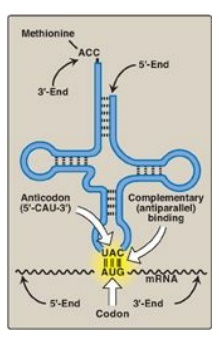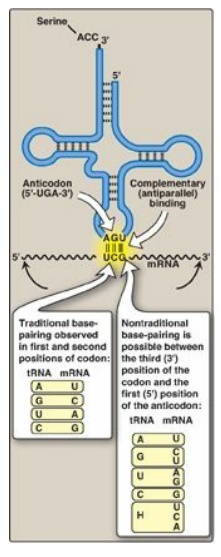Codon Recognition by Transfer RNA
| Home | | Biochemistry |Chapter: Biochemistry : Protein Synthesis
Correct pairing of the codon in the mRNA with the anticodon of the tRNA is essential for accurate translation.
CODON RECOGNITION BY TRANSFER RNA
Correct pairing of the
codon in the mRNA with the anticodon of the tRNA is essential for accurate
translation (see Figure 31.6). Some tRNAs (isoaccepting tRNAs) recognize more than
one codon for a given amino acid.

Figure 31.6 Complementary, antiparallel binding of the anticodon for methionyl-tRNA (CAU) to the messenger RNA (mRNA) codon for methionine (AUG), the initiation codon for translation.
A. Antiparallel binding between codon and anticodon
Binding of the tRNA
anticodon to the mRNA codon follows the rules of complementary and antiparallel
binding, that is, the mRNA codon is “read” 5→3 by an anticodon pairing in the
“flipped” (3→5) orientation (Figure 31.9). [Note: Nucleotide sequences are
always assumed to be written in the 5 to 3 direction unless otherwise noted.
Two nucleotide sequences orient in an antiparallel manner.]

Figure 31.9 Wobble: Nontraditional base-pairing between the 5I -nucleotide (first nucleotide) of the anticodon with the 3I -nucleotide (last nucleotide) of the codon. Hypoxanthine (H) is the product of adenine deamination and the base in the nucleotide, inosine monophosphate (IMP). A = adenine; G = guanine; C = cytosine; U = uracil; tRNA = transfer RNA; mRNA = messenger RNA.
B. Wobble hypothesis
The mechanism by which tRNAs can recognize more than one codon for a specific amino acid is described by the “wobble” hypothesis, which states that codon– anticodon pairing follows the traditional Watson-Crick rules (C pairs with G and A pairs with U) for the first two bases of the codon but can be less stringent for the last base. The base at the 5-end of the anticodon (the “first” base of the anticodon) is not as spatially defined as the other two bases. Movement of that first base allows nontraditional base-pairing with the 3-base of the codon (the “last” base of the codon). This movement is called wobble and allows a single tRNA to recognize more than one codon. Examples of these flexible pairings are shown in Figure 31.9. The result of wobble is that there need not be 61 tRNA species to read the 61 codons that code for amino acids.
Related Topics
